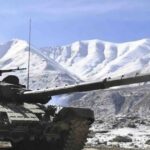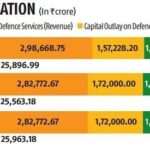
By Vikas Gupta
Defence News of India, 3rd Nov 23
It has been over a year-and-a-half since the Ministry of Defence (MoD), facing criticism for rising personnel costs, announced a new recruitment scheme named Agnipath Yojana. It was aimed at lowering the average age of India’s military by four-to-five years, from the current average of 32 years to a more sustainable average of 27 years. Given the stakes involved, it would be essential to evaluate how the scheme is faring at this point, whether any course corrections are needed or whether it is time to deepen the government’s commitment to Agnipath.
Belying its filmi name, the Agnipath scheme is a simple concept. It is based on the truism that soldiers who enlist for shorter durations cost the government less each year than those who make a career of the military. The MoD has presented it as a “transformative measure” that will change the recruitment pattern of Agniveers;the term for soldiers, sailors and airmen who join under the Agnipath Yojana. The intention is to switch from the current long-service model, involving a 15-year bond that culminates in a lifelong pension; to a mainly short-service contract under which annual tranches of recruits will serve for four years. After that, 25 per cent of all Agniveers are retained for full careers, while 75 per cent of them go home without a pension.
The military’s personnel expenditure is, in the very least, alarming. During financial year 2021-22, actual personnel expenditure, including salaries, allowances and pensions, came to Rs 2,74,014 crore (2.7 trillion) – almost 55 per cent of the total defence budget of Rs 5,00,681 crore (Rs 5 trillion).
Manpower allocations: Defence budget 2023-24
(In rupees crores)
|
|
2021-22 (Actual) |
2022-23 (BE) |
2022-23 (RE) |
2023-24 (BE) |
|
|
|
|
|
|
|
|
|
|
|
|
|
Salaries and allowances |
157214 |
172874 |
175535 |
184906 |
|
|
|
|
|
|
|
Non-manpower revenue expenditure |
75824 |
64869 |
89618 |
90508 |
|
|
|
|
|
|
|
Ministry of Defence |
6058 |
7306 |
8244 |
8544 |
|
|
|
|
|
|
|
Capital expenditure |
144785 |
160420 |
157979 |
171375 |
|
|
|
|
|
|
|
Pensions |
116800 |
119697 |
153414 |
138205 |
|
|
|
|
|
|
|
TOTAL DEFENCE BUDGET |
500681 |
525166 |
584790 |
593538 |
|
|
|
|
|
|
|
Central government spending |
3793801 |
3944909 |
4187232 |
4503097 |
|
|
|
|
|
|
|
Percentage of govt spending |
13.2% |
13.25% |
14% |
13.2% |
|
|
|
|
|
|
(Source: compiled from finance ministry’s budget documents 2023-24)
During the next financial year, i.e. FY 2022-23, the actual personnel expenditure rose by a percentage point to Rs 3,28,949 crore (Rs 3.28 trillion) – over 56 per cent of the total defence budget of Rs 5,84,790 crore (Rs 5.84 trillion).
Only in the current financial year, i.e. budget estimates (BE) 2023-24, has the personnel bill remained stable at Rs 3,23,111 crore (3.23 trillion). That amounts to about 55 per cent of this year’s total defence allocation of Rs 5,93,538 crore (Rs 5.93 trillions).
The objective of the Agnipath Yojana is clearly to whittle down pension liabilities. Pensions, which were becoming unaffordable with the implementation of the One Rank, One Pension scheme in 2015, still constitute an unaffordable chunk of the annual defence budget. In the current year’s (FY 2023-24) defence allocation of Rs 593,538 crore (Rs 5.93 trillion), a whopping 23 per cent – about Rs 1,36,514 crore (Rs 1.36 trillion) – is allocated for pensions.
Of each annual batch of recruits – 46,000 recruits for each of the first four years, 90,000 in the fifth year; and 125,000 from the sixth year onwards – one-quarter will be chosen to be retained in service. This means that, from the 10th year, Agnipath will yield 31,250 soldiers each year (25 per cent of 125,000) for extended service tenures with pensions, while another 93,750 will head home after completing their four-year service tenures.
Besides a younger military, the MoD anticipates a range of benefits from Agnipath. It sees the 75 per cent who are discharged after four years as disciplined employees who could side-step smoothly into government and factory jobs. For these retiring Agniveers, the government has reserved jobs, including 10 per cent of vacancies in central armed police forces (CAPFs), the Coast Guard, in defence ministry civilian posts and in 16 defence public sector undertakings. Another 85 private firms have promised jobs to retiring Agniveers. A “Seva Nidhi” package at the end of the four-year engagement will give the retiring Agniveer a tax-free Rs 11-12 lakhs. Even so, the Agniveer’s remuneration, which starts at Rs 30,000 per month and rises over three years to Rs 40,000 per month, ensures that he remains at a lower pay grade than even the junior-most regular soldier in the unit.
The Agniveer scheme’s bottom line amounts to extending to the rank and file (or enlisted personnel) the more conventional “short service commission”. This currently provides for officers (but not the rank and file) to join service for a limited duration – a period of five years, extendable by another five years and then by another four, making up a maximum service period of 14 years. For the military, this provides the field force with officers at the combat commander level, up to the rank of lieutenant colonel. These officers serve as cannon fodder, and then fade away at the stage when competition heats up for higher promotion vacancies. Like with the Agniveer scheme, the best officers in each short service batch, who have distinguished themselves professionally during their service periods, are granted extensions of service, allowing them to remain in uniform and compete for higher ranks.
Another method of obtaining the services of high-quality soldiers is by raising additional “scouts battalions” – border units, manned by border people, which remain located in the vicinity of their home villages. The hostile terrain and harsh weather conditions do not deter these men who have been born and bred in these areas and, many believe, are genetically endowed to operate there. Both India and Pakistan have a fine tradition of “scouts battalions”, such as India’s five battalions of Ladakh Scouts, which have recently been given the status of full-fledged, regular infantry battalions. Since independence, the Ladakh Scouts have operated in these areas, giving birth to Ladakhi legends such as Colonel Chhewang Rinchen who, as a 17-year-old boy, beat back Pakistani invaders in 1947, winning the first of his two Mahavir Chakras and establishing himself as one of India’s most enduring military heroes. Later, during the Kargil War in 1999, another Ladakhi icon, Colonel Sonam Wangchuk became one of the Indian Army’s icons by beating back Pakistani infiltrators in Chorbat La. While regular Indian units, the majority of them from the plains, struggle to adapt to Himalayan conditions, the Ladakh Scouts have no such difficulties. Raising a large number of units from the Himalayan areas and recruiting locals to man them would not just create jobs for locals in these remote border areas but also ensure defence of our territories by natural, high-altitude soldiers who are motivated by the responsibility of defending their homelands.
Finally, more cost-effective personnel and units can be generated through the Territorial Army (TA), composed of part-time infantry and engineer units that are called into service when needed. The TA has ten “ecological battalions” that work for environmental restoration in the country, carrying out afforestation in rugged and inhospitable terrain, reviving wetlands, restoring water bodies and contributing to the Clean Ganga project. TA Battalions also perform specialist tasks, such as restoring sabotaged services of the Indian Railways and restoring pipelines of the oil sector public sector undertakings.
[ENDS]






